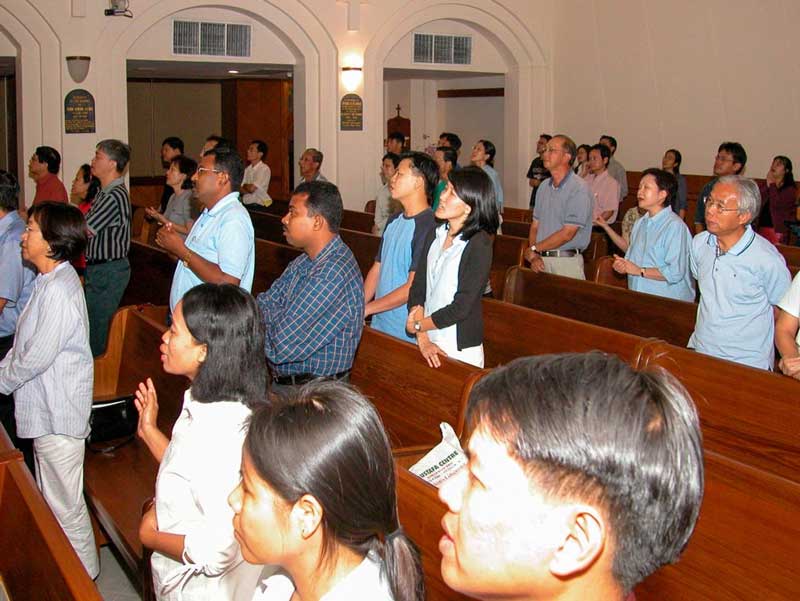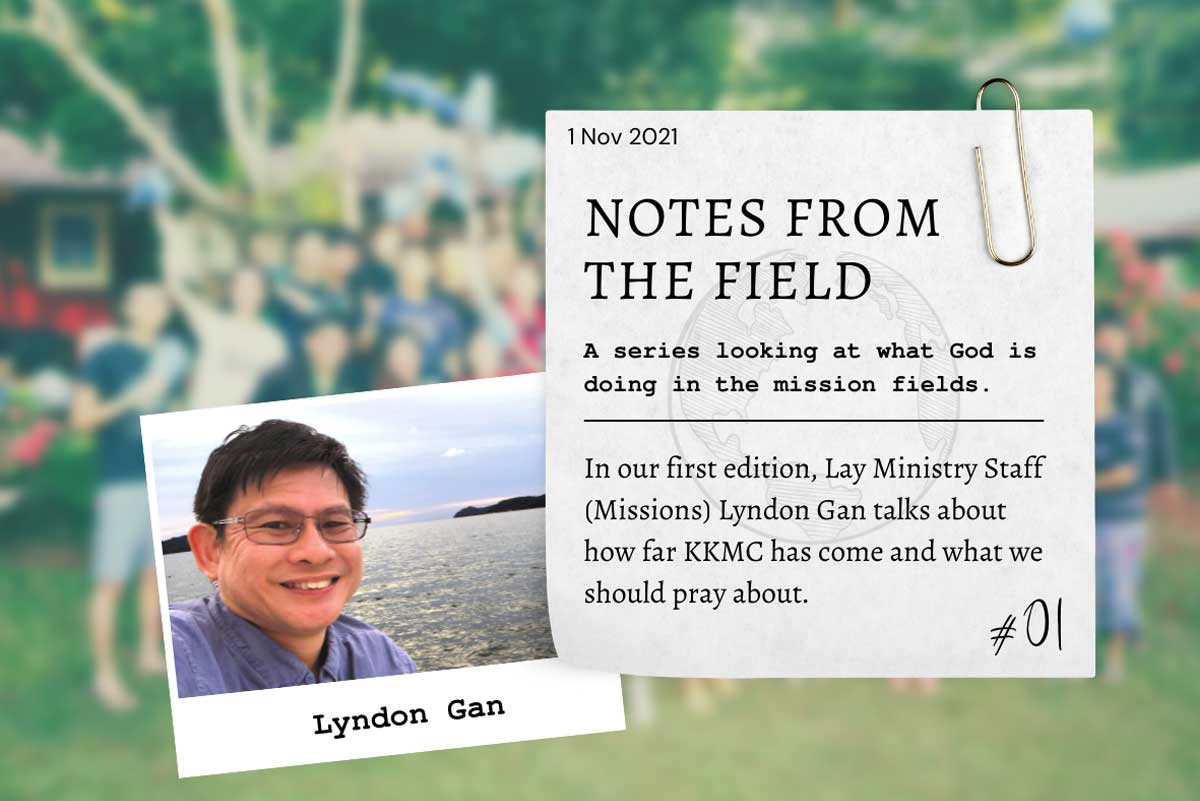“Notes From The Field” is a series examining what God is doing in the mission fields. What is happening on the KKMC mission frontlines? Do we understand what missions is in the first place? In our first edition, Lay Ministry Staff (Missions) Lyndon Gan talks about how far KKMC has come and what we should pray about.
We often think of missions as undertaken by missionaries who go into a particular mission field.
There is a misconception that the cutting edge of missions is undertaken by those who go, while those who serve as senders are somehow playing a lesser role. Then at the bottom of the scale are the disobedient, uninvolved Christians who neither go nor send.
However the Bible tells us that those who send are as important as those who go.
But how can they call on him to save them unless they believe in him? And how can they believe in him if they have never heard about him? And how can they hear about him unless someone tells them? And how will anyone go and tell them without being sent? That is why the Scriptures say, “How beautiful are the feet of messengers who bring good news!”
(Romans 10:14-15)
These verses show the missions endeavour from 3 different perspectives: Those who need to hear the good news and come to believe in Jesus, those who share the good news, and those who send the people to share.
For a church to be effective in sending cross-cultural missionaries, there has to be a strong sending base of partners who would provide the prayer, logistic, communication, financial and moral support.
To develop such a base of supporters, we need a ministry to educate and expose church members to missions. The local church needs to mobilise in order for members to become cross-cultural missionaries. There is also the need to develop the administrative structures to support the missions endeavour.
In short, for a local church to have a sustained involvement in God’s world missions, a lot of missions work has to be done in the local church level first.
How has KKMC grown in missions?

Since 1985, KKMC has sent 28 members to serve in missions. Out of these 28 missionaries, 27 were commissioned between 1985 – 2012. This does not include our Lahu work or missionaries adopted with Indian Missionary Society.
To be able to send these missionaries, KKMC had to establish
- Consistency and faithfulness in praying for our missionaries
- The necessary policies and organisational structure to support the missionaries
- A greater awareness and involvement in members of their own roles in God’s Great Commission.
Many things we now take for granted as part of KKMC’s church life did not exist back in 1985. There wasn’t a regular Church Prayer Time for missions. Mission trips were few and far between and most members did not even consider going on such trips. It would probably amaze our church members of 1985 if they knew that by 2012, KKMC would have sent 27 homegrown members to the mission field, have quarterly prayer meetings for missions and organise annual mission trips for children, youth and adults.
However, much work remains to be done. Since 2013, we have only sent one new missionary. Perhaps fresh work needs to be done to challenge and mobilise a new generation of members to be involved in missions.
What are some of the challenges that lie ahead?

The global pandemic and hostility to Christianity in some parts of the world has perhaps made churches more risk adverse in the sending of missionaries.
When is “safety first” a prudent and wise course of action and when does it cross over to become an idol and obstacle to missions? Does a “safety first” mentality betray a lack of confidence in God?
That there is no easy answer to this question shows that there is work to be done at the local church before we can send missionaries.
Did you ever think of going into the mission field?
Of course!
When I was fresh out of university in the late 1980s, I had a vague sense of wanting to be involved in God’s mission.
The Bible was clear enough in Matthew 28:18-20, which says, “Make disciples of all nations”. How would I, as a fresh graduate with my whole life ahead of me respond?
It was the era when the church heard the clarion call – there were unreached people groups with little or no access to the Gospel of Jesus Christ. Many of such people groups were found on the so called 10/40 Window – a term coined by Christian missionary Luis Bush in 1990 to refer to places located between 10 and 40 degrees north of the equator where people had the least access to the Christian message.
The Methodist Church in Singapore also seemed to be gearing up to a new era of missions when the Methodist Missions Society was inaugurated on 30 September 1991 as an agency under the then Council of Missions.
There was a buzz around the Christian churches about missions as well, leading to the first GoForth Missions conference in 2002.
My circle of friends involved in missions tried to model our lives under the watchword “preparing to go”. For me that practically meant getting a few years of work experience before getting theological equipped in Trinity Theological College (TTC).
While studying at TTC, the late Rev Dr Clarence Lim, who was the Pastor-In- Charge of KKMC at that time, made a case that I should also get some experience working in a local church, particularly in the area of missions. I felt that made sense and thought I would at most work in the local church for few years before heading overseas for cross-cultural missions.
However, much as I prayed about going overseas, it was the conviction to stay and serve in the local church in missions that grew stronger.
Initially some friends who had become cross-cultural missionaries overseas would ask me why I was still hanging around in Singapore when there was so much to be done in the overseas fields.
I have come to realise that it can be crippling and even guilt inducing for some Christians when their involvement in missions is reduced to whether they are a “goer” or “sender”, with the “goer” regarded as the one with the higher calling.
More important than what we do is our identity in Christ. As children of God, we are citizens and agents of God’s kingdom. That means every single one of God’s sons and daughters are sent to live our lives in such a way that people can clearly see what it means when Jesus is indeed king. This is our missions identity and it is not limited to those who cross cultural and linguistic barriers to proclaim the gospel. All of us are sent on God’s mission, bearing the Great Commission. As long as we are living that identity, we should not feel that we are not playing our part.
We should not downplay the many challenges that those who are called to go face. Again the best way to bring the gospel of Jesus to those who have not heard is to live among them. But more importantly, I also believe that all of us should be prepared to go wherever God calls us. For me, that call has been to work in missions in the home base.
What do you think is the most important work for KKMC to do in missions?

The answer has to be prayer. Not only for missions but for our entire Christian life.
The Lord’s Prayer begins with: “Our Father in heaven” followed by “hallowed be your name”.
However though God is in fact the king of the world, His authority has been regularly usurped – both by humans who say, “We will do it our own way” and by darker forces which the Bible terms as idols.
Therefore Jesus taught us to pray “your kingdom come, your will be done, on earth as it is in heaven.” (Matthew 6:10)
This is a pleading for God to drive back other pretension to his kingship and asking for God’s kingdom and rule to be established on earth through the work of Jesus Christ. This is really another way of describing God’s missions.
The Lord’s Prayer is the beginning, the foundation as well as the destination and end of the work of missions. It is from praying that we begin to share God’s heart in wanting to establish His rule and His will on earth – a rule of love that will free people from sin and oppression. It is from praying that we will come to know what God is calling us as individuals and as a church to do.


